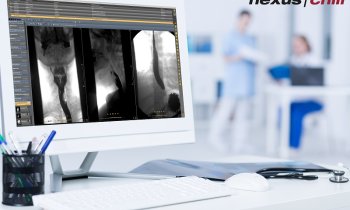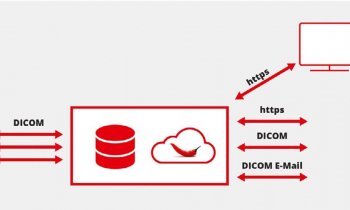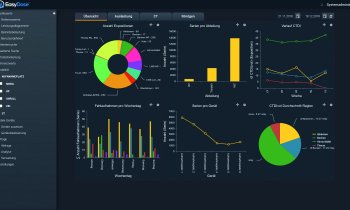The Hospital Manager Symposium
Participation in the Hospital Manager Symposium, which is organized by EUROPEAN HOSPITAL in cooperation with the European Congress of Radiology and which is part of the congress, has increased continuously since its introduction six years ago. Last year about 250 attendees listened to the lectures and discussions.

What makes this event so successful is the combination of three critical areas (apart from medical knowledge) that make for a healthy radiology department: management, IT and finance.
Once again, this event has invited leading experts in these fields to give talks and lead discussions with participating hospital and department managers.
MANAGEMENT
Stefan Furtmüller MA, Manager of Contrast Management-Consulting
‘What makes a hospital successful?’
The general conditions for hospital management are not easy (too many stakeholders and interest groups, different finance systems, etc.) Nonetheless, the existing conditions and structures still offer numerous opportunities to increase efficiency with regards to customised and high-quality patient care. Business tools and methods can help here. Some hospital groups make good use of these approaches (at least in some areas) and for most organisations there is still quite a lot of room for improvement.
Leonardo La Pietra, CEO of the European Institute of Oncology
‘Accreditation and standards of excellence in Europe’
Leonardo La Pietra will describe the individual management of the European Institute of Oncology and experience with Joint Commission International Accreditation.
In perspective, the MCC should be part of a more integrated patient file, aimed to accompany the patient in his or her journey through the healthcare system. Information technology (IT), with the realisation of an electronic patient’s record (EPR), accessible online from different places, could provide a valuable aid in the management of medication continuity.
Dr. Wilhem Marhold, Director of teh Vienna Hospital Association, Vienna, Austria
`Structural changes in Viennese hospital structure`
The aim of the Vienna hospital concept is to achieve regional balance of medical care in Vienna. The new North Hospital is the core of this concept.
“The Vienna hospital reform project is concerned with enhancing efficiency and achieving a synergy of the existing facilities,” says Dr. Wilhelm Marhold, the General Manager of KAV.
“New tasks and new identities for old hospital sites instead of the uncreative act of closing hospitals” is the motto. The Vienna Hospital Reform focuses on enhancing the efficiency of the entire landscape of Viennese hospitals.
The city of Vienna is enhancing efficiency in the health sector in order to be able to offer top-level medicine to all residents of the city, irrespective of their origin, gender, income or age. This includes exact screening as to where what type of service is being offered and how this may possibly be offered at a better price.
Setting new points of emphasis in the whole of Vienna
The Floridsdorf Hospital, the Semmelweis Women’s Clinic and the Orthopedic Hospital of Gersthof, as they exist now, will be completely shifted to the new hospital. The departments of heart surgery, cardiology, and parts of neurology from Hietzing hospital will be shifted to the new North Hospital. Hietzing hospital will be transformed into a highly modern clinic for widespread diseases such as stroke, diabetes and rheumatism, and will continue to offer cardiac care as part of its internal-medicine services.
Otto-Wagner-Spital will remain a specialized hospital for orthopedics, psychiatry, neurology and pulmology. Parts of the departments of pulmology and chest surgery as well as psychiatry will be transferred to the North Hospital. The goal is to achieve further regionalization and tend to psychiatric patients in specialized hospitals. A part of the pediatric department of Wilhelminenspital will be shifted to the North Hospital.
Additional beds will be provided at the new location for pediatric and adolescent psychiatry as well as trauma surgery.
The new hospital will be built by 2013 in the northern part of Vienna and will have 842 beds of the most recent standard, provided as single-bed or double-bed rooms. It will be operated as a specialized hospital.
The aim of this hospital concept is to expand hospital structures in keeping with the demographic development of the city and simultaneously transfer or close down hospital locations of the preceding centuries.
By doing so, hospitals with specific points of focus will be created, and optimized operating cost structures achieved.
Niall Dickson, Chief Executive Kings Fund London, London, UK
`Driving up performance in acute care`
Public spending on health and long-term care is a major source of fiscal pressure in most OECD countries, amounting to, on average, some 9% of GDP in 2006, and reaching as much 15% in the US. Spending growth at the rate it has been seen in the last 10 years in most countries is unsustainable.
There is no doubt that growing economic pressures will limit growth in healthcare funding. At the same time governments will face sustained demand for investment driven by rising public expectations. While the World Health Organisation report of the Commission on the Social Determinants of Health reported that health care built on the principle of universal coverage is important, health care systems across Europe are under pressure. A sustained economic downturn may result in a move towards a “safety net” of provision only. In any event, the increasing pressure on healthcare resources in the face of growth in demand and in capacity to treat is likely to drive a tighter definition of benefits packages.
Aging populations and lifestyle behaviours, in particular, dramatic rises in adult and child obesity will drive demand and the rapid introduction of technological and medical advances will also play a part in increasing health care costs.
What is the answer? In short, doing more for less. A seminal review in the UK concluded that while significant increases in funding had delivered notable improvements – more staff and equipment; improved infrastructure; significantly reduced waiting times and better access to care, there were not concurrent increases in productivity.
Efficiency and productivity will have to join quality as driving forces, savings need to be achieved not by the traditional methods of freezing posts, delaying care and cutting back on ‘administration’ but by genuine redesign of services and setting clear priorities. Providers and commissioners of health care must ensure they have the leaders in place who can deliver value by ensuring that even as money becomes tighter, care improves. This is not an impossible task – poorly designed services ultimately waste money. As Don Berwick of the Institute of Healthcare Improvement in the US states clearly that "higher quality costs less”. Technological and medical advance are allowing more care options in more places. Electronic patient records and the miniaturisation of diagnostics, frees clinicians and patients from hospital buildings, and offers the potential for more patient focused services.
The onus now is on local health care managers and clinicians to create a shared vision for their health services ensuring that the right incentives are in place to get them there, despite the stormy financial waters ahead.
David Wormald, Assistant Vice President Hamilton Health Sciences Corporation, St Joseph´s Health Care, McMaster University, Hamilton
`Lean architecture that reflects quality of care`
The new Diagnostic Imaging Department at St. Joseph’s healthcare is now well positioned as a result of employing an innovative approach for designing its new facility. The benefits are far reaching and to date include a 54.3% improvement in clinical efficiency and an 8.5% improvement in patient travel distances. The ability to achieve these efficiencies in an expanded facility were necessary in our environment of staffing shortages, increasing demand for procedures, our aging population and our growing clinical services. This project was consistent with St. Joseph’s culture of continuous improvement, which fully engages our committed workforce in optimizing our patient care environments, our patient outcomes and overall hospital performance.
Today, more and more research is surfacing about how the healthcare environment is directly linked to positive patient outcomes. Evidence-based design helps create an environment in which patients and families feel as safe and comfortable as possible. As well, it promotes efficiencies in staff workflow and helps decrease levels of stress and anxiety in patients, family members and staff.
INFORMATION TECHNOLOGY
Dr Marco Marchetti, Medical Director of Unità di valutazione delle tecnologie
‘The impact of IT on the healthcare system and organisation’
Dr Marchetti will explore and provide an overview of the impact of IT radiology innovation processes on healthcare systems and healthcare organisations, according to the principles of Health Technology Assessment (HTA). HTA is a multidisciplinary process that produces information on the impact of technology introduction to healthcare systems. This is a useful tool because the information produced aids policy-making decisions at macro-level (national, regional level) and meso-level (institutional level or healthcare organisational level). Information produced during the HTA process relates to different aspects: effectiveness, economic, organisational, social, ethical and legal impacts.
Dr Hanna Pohjonen, Healthcare IT Consultant, RosaliecoOy
‘Enablers for teleradiology’
In her speech, Hanna Pohjonen will discuss the advantages of e-marketplaces that offer a secure platform for the provision and consumption of imaging services by developing a new working environment for professionals and teams, a shared workspace for cross-border consultations and access to individual images and patient records.
Vasco Luis Jose de Mello, CEO of Quiron Hospital
‘Investment strategies and financing solutions in healthcare projects’
Henrik Agrell; Vice President and co-founder of Telemedicine Clinick (TMC) in Barcelona
`Teleradiology - moving from black box solutions to integrated partnership`
The major challenges facing national healthcare systems worldwide call for new and innovative solutions for the production and delivery of healthcare services. In the field of medical imaging, there is a problematic imbalance between an increasing demand in imaging services partly due to an aging population and a growing shortage of medical staff and funding. In addition to this, more and more advanced imaging processes require access to subspecialist radiologists for an increasing number of cases. Professional teleradiology services could be one potential solution to these challenges. Centralising subspecialist competence in a highly-efficient and quality-controlled production environment and distributing this resource via integrated ITsolutions at point of need, could give public and private healthcare players access to exactly the resource they need and when they need it.
Teleradiology has been tested during decades in a huge number of more or less successful projects. However, some years ago when the first teleradioloy service providers entered the market, hospitals started to use this solution on a more continuous basis. In its infancy, teleradiology was a fairy basic service with remote radiologists reporting directly to the hospitals’ RIS/PACS environments during their spare time. With growing competition and increased awareness amongst the clients, teleradiology is now rapidly developing from a “black box” outsourced solution to a highly integrated partnership, which requires different structures and new and more sophisticated production processes for teleradiology service providers to be able to meet a different level of demand in the market.
In this presentation, you will be able to follow the development of Telemedicine Clinic (TMC), the largest European teleradiology service provider, with specific focus on efficiency and various challenges related to this area.
Prof. Dr. Wilfried von Eiff, Professor at Münster University and CEO of CKM GmbH, Center of Hospital Management Münster, Germany
`RIS/PACS in practice: How coopetition enables RIS/PACS`
The MARA Coopetition Study, recently carried out by the Center for Hospital Management (University of Muenster), demonstrated a couple of facts that characterize the pitfalls typically occuring under RIS/PACS implementation processes:
53% of RIS/PACS users have been able to contain costs und to increase productivity, but
only 13% are willing to recommend the RIS/PACS solution from a specific vendor without any reservation.
RIS/PACS users file a number of complaints on vendors, e.g. regarding lack of cooperation, disregard of individual user requirements, poor ability to reengineer and enhance patient-centered processes.
This presentation provides, in a nutshell, focused information about user requirements, supplier behaviour and user experiences made under RIS/PACS implementation processes.
FINANCING
Vasco Luis Jose de Mello, CEO of Quiron Hospital
´Investment strategies and financing solutions in healthcare projects´
He will focus on two key issues – how to minimise investment needs and how to optimise financing solutions – with an actual perspective from a company with the biggest infrastructure plan in Spain in the last 5 years.
Dr. Axel Paeger, CEO, AMEOS AG, Zurich
`Financinf of medical equipment within hospital groups - which strategy?`
Financing sources for hospital technology are increasingly heterogeneous and mixed. While public funding is still the most frequently used instrument, equity is becoming increasingly important particularly where the investment might be recovered at least partially via charges. The same holds true for debt which currently has the advantage of being fairly cheap. Leasing is another option which is gaining importance. While leasing relieves the balance sheet to a certain degree, leasing payments have to be earned just like interest or return on equity. Most decisions in favour of leasing are based on strategic considerations: since a hospital should concentrate on its core competency – patient care – it seems to make sense to enter into an operative leasing contract which allows the hospital to hand over all equipment management tasks to a partner. Particularly public hospitals, however, opt for this scenario for purely economic reasons: the leasing partner pays his staff much lower salaries and can thus offer the services at a better price than the in-house technology department.
André Hoppen, Sales Manager VR Medico, Berlin
`Do you know the right financing strategy for your hospital?`
Leasing medical technology is often a necessary investment into the future of a hospital but not an easy choice to make. Being affected by cost savings and restricted budgets, the question of whether and how much to invest in updating medical equipment, puts hospital managers under high pressure. The fear of making the wrong decisions and insecurity around future budgets makes it important to find the right financial solution shaped to the specific needs of individual hospitals. When it comes to leasing contracts, hospitals can choose between manufacturer-owned leasing; the independent leasing companies that mainly offer contracts with small business volumes, and bank-linked leasing. Before a decision is made on which strategy to choose, there has to be a clear understanding of how a hospital draws up the balance sheets, as well as why and how balances function, based on the Diagnosis Related Groups (DRGs). Additionally, the balance sheets in the various European countries as well as the specific requirements as to how a leasing contract should be set up, differ. Another important point is to monitor whether the facility actually generates enough money in working with the leased equipment to cover the monthly outgoings of the lease. This involves assessing how many private payers, private patients, patients covered by medical insurers and referring doctors are passing through and what types of patients with what GOA figure (physician fee schedule figure) these are. Considering all this with thought, the lease contract should in each case be put to the acid test before closed.
The 6th Hospital Manager Symposium –
7 March 2009, Vienna, Austria
28.01.2009











